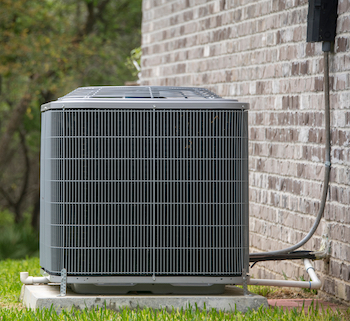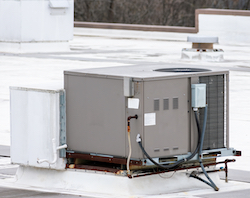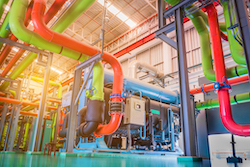 Brief History and Overview of Modern Air Conditioning
Brief History and Overview of Modern Air ConditioningThroughout history, some inventions have greatly improved people's quality of life. This includes air conditioning.
Heating is never a big problem: people invented fire and fireplace about 2 million years ago, which enabled them to migrate to colder climates. However, cooling has always been a challenge.
Brief History of Modern Air Conditioning
Until the late 1800s, air circulation (fan) and evaporative cooling were the main ways to eliminate heat. In 1902, an engineer named Willis Carrier tried to solve the problem of high humidity, which had a negative impact on the paper rolls, ink and machines of the Buffalo (NY) printing plant. On a foggy day, when he stared at the fog, Carrier realized that he could dry the air by condensing it through cold water. Within a year, he invented an electric system to remove moisture from indoor air, which also has the effect of reducing air temperature. This is the beginning of modern air conditioning.
Carrier can't imagine that his invention has fundamentally changed the way we work and live in many ways. Not only did the printing press run better, but mechanical cooling improved the manufacture of food, beverages, medicines and petrochemical products. Hospitals, retailers, theaters and the transport industry, especially air travel, benefit from being able to control temperature and humidity. By cooling server rooms and data centers, air conditioners also make high-tech computing and the Internet possible. In short, air conditioning has given birth to the global economy, not to mention making families, offices, schools, shops and chapels more bearable in sultry weather. No wonder Time magazine rated Carrier as the 100 most influential people in the 20th century.
Types of residential, commercial and industrial HVAC
More than a century after Carrier obtained its initial patent, there are a variety of air-conditioning systems with different sizes, technologies and capacities depending on the areas to be cooled. Naturally, residential systems are different from commercial and industrial systems because of different space and user needs.
Central air-conditioning condensing unit
For older houses and buildings, separate window units provide welcome relief during periods of high temperature and humidity, but are usually only suitable for one room. Since about 2000, central air-conditioning has been ubiquitous in Chinese families. Its advantages are quiet, unobtrusive, and can effectively cool the whole house. The forced ventilation system can be operated using electricity or natural gas and is less expensive than new technologies. Disadvantages: They require a pipe network, which is difficult and expensive to add rooms or retrofit in old buildings. In historical buildings, such transformation is not desirable, or even impossible.
Mini split system
Mini splits do not require ductwork and vents and are an excellent alternative to central air. The "mini" part of its name comes from low-key indoor evaporator devices, which are installed on the wall and only need to make small holes for various pipelines: refrigerant, condensate drain pipe and power. The "split" part refers to the outdoor condenser unit, which is separated from the indoor unit or "split". Although small split systems are more expensive and have lower capacity due to their smaller size, they are more energy efficient than forced ventilation and therefore have lower operating costs. Many new homes and buildings in Europe and Asia are built with pipeless mini split systems because they can also be used as heaters and allow each room to set its own temperature.
VRF outdoor unit
Japan Daikin Company invented VRF (Variable Refrigerant Flow) in 1982, but the technology was not widely used in the Chinese market until the early 2008. Its name comes from the frequency conversion compressor and fan of the outdoor unit, which change the speed by regulating the power supply. The rate of change determines how much refrigerant the compressor delivers. VRF is similar to mini splits because it has indoor/outdoor units, no pipes, and can be heated and cooled. The main difference is that VRF units have higher capacity, making VRF an ideal choice for warehouses, industrial facilities and commercial buildings. It is also flexible: a system can heat or cool different areas of the building at the same time.
Encapsulated RTU
Many commercial buildings in Asia and the Americas have encapsulated roof units (RTUs) for cooling and sometimes heating. As the name implies, all HVAC components used for cooling (and heating) cycles are contained in a large metal box. In fact, people can think of it as a great cousin of the standard window unit! The piping system is directly connected to the bottom of the RTU, delivering cooling air to the building below and receiving hot air. (For example, if placed next to a building, a package can also have horizontal connections.) RTUs start the system with constant air volume (CAV), which means they have a fixed air flow rate optimized for a specific area. However, this constant flow rate sometimes means that some parts of the building have uneven cooling, while others require more air circulation. The variable air volume (VAV) system solves these problems, improves comfort and improves energy efficiency.
Chiller system
Water is both a hot fluid and a refrigerant. In traditional boiler systems, which are common in homes and industrial facilities, hot water or steam radiates heat in indoor spaces. Instead, the chilled water system absorbs heat because it pushes water cooled to about 45 ° F (7 ° C) through pipes under the floor, walls, and ceilings. This method can cool down a building, or in the case of water chillers, serve several buildings or even the entire high-density area (regional cooling).
Geothermal heating and cooling
The temperature fluctuates greatly, but at 10 feet (3m) below the ground, the annual temperature is 55 ° F (13 ° C). Geothermal heating and cooling are expensive in the early stage, but as consumers and enterprises seek ways to reduce energy consumption, they are attracting more interest. Basically, these systems consist of a loop of buried pipes through which water circulates. When the weather is cold, air temperature water is sent to the ground for heating; When it moves back to the ground, the heat pump increases the water to the required temperature and transports it through pipes in the building. In hot weather, the system uses the same principle, but the opposite. Without outdoor/roof units, the geothermal system is very quiet and beautiful. But more importantly, more commercial developers are seeking LEED (Leadership in Energy and Environmental Design) certification for their projects, and alternative HVAC solutions such as geothermal play an important role in this goal.

 Brief History and Overview of Modern Air Conditioning
Brief History and Overview of Modern Air Conditioning






